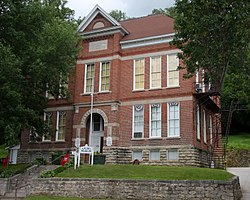Buffalo County | |
|---|---|
 Alma Area Museum in Old Buffalo County Training School and Teachers College Building in Alma, Wisconsin. | |
 Location within the U.S. state of Wisconsin | |
 Wisconsin's location within the U.S. | |
| Coordinates: 44°23′N91°45′W / 44.38°N 91.75°W | |
| Country | |
| State | |
| Founded | 1854 |
| Named after | Buffalo River |
| Seat | Alma |
| Largest city | Mondovi |
| Area | |
• Total | 710 sq mi (1,800 km2) |
| • Land | 672 sq mi (1,740 km2) |
| • Water | 38 sq mi (98 km2) 5.3% |
| Population | |
• Total | 13,317 |
• Estimate (2024) | 13,464 |
| • Density | 19.8/sq mi (7.65/km2) |
| Time zone | UTC−6 (Central) |
| • Summer (DST) | UTC−5 (CDT) |
| Congressional district | 3rd |
| Website | www |
Buffalo County is a county located in the U.S. state of Wisconsin. As of the 2020 census, the population was 13,317. [1] Its county seat is Alma. [2] The county was created in 1853 and organized the following year. [3] [4] The county is considered a high-farming concentration county by the U.S. Department of Agriculture, meaning at least 20 percent of its earnings came from agriculture. [5]
Contents
- History
- Geography
- Adjacent counties
- Major highways
- Railroads
- Buses
- Demographics
- 2020 census
- 2000 census
- Communities
- Cities
- Villages
- Towns
- Census-designated places
- Other unincorporated communities
- Railroad junctions
- Ghost towns/neighborhoods
- Politics
- Notable people
- See also
- References
- Further reading
- External links


